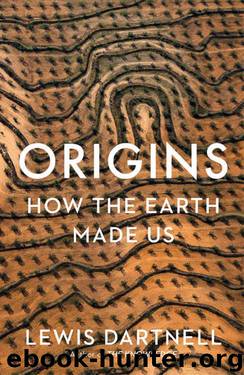Origins by Lewis Dartnell

Author:Lewis Dartnell [Dartnell, Lewis]
Language: eng
Format: epub, azw3
ISBN: 9781473547339
Publisher: Random House
Published: 2019-01-30T16:00:00+00:00
SEAS OF GRASS
We have seen how the bands of deserts running around the world are created by the dry, descending air of the circulation pattern in the Earth’s atmosphere (as well as the rain-shadow effect behind mountain ranges like the Himalayas). But the temperature gradient from the planet’s poles towards the equator also defines a series of layered climate zones, and the distinct ecosystems that are found within them.32 These horizontal stripes on our planet exist in both hemispheres but they are more pronounced in the Northern with its far greater land mass.
Here the northernmost zone, nearest the pole and stretching across northern Siberia, Canada and Alaska, is tundra. Very cold temperatures and a short growing season produce a bleak landscape in which little more survives than scattered dwarf shrubs, heath and hardy lichen clinging to rocks. It is populated only by reindeer herders or caribou hunters.33
South of the tundra lies the taiga, a stripe of dense conifer forests. This subarctic ecological zone covers most of Canada, Scandinavia, Finland and Russia, and gradually turns into the deciduous forests of Northern Europe and the United States at its southern limit. Whilst unsuited for agriculture or raising livestock, the taiga has been an important source of furs, including mink, sable, ermine and fox. In early modern history the demand for furs drove trappers across this taiga belt, and it turned Moscow into a major trade hub. In pursuit of furs, Russia expanded eastwards through the fifteenth and sixteenth centuries, across Siberia as far as the Pacific coast and the northern frontiers of the Chinese Qing Empire.34 In the seventeenth century, French and other European trappers similarly pushed through the Canadian forests.35 fn6
South of the tundra, our planet’s climate becomes temperate, before turning tropical closer to the equator. This pattern of ecological zones, arranged like stripes between pole and equator, has defined the lifestyles and economic possibilities of the people living within them throughout history. One ecological region in particular has had an enduring influence on the civilisations around the margins of the Eurasian interior.
Sandwiched between the northern, cold climatic band of the taiga and the chains of deserts to the south is a vast tract of grasslands. In Eurasia, this ecological zone is known as the steppes, and they sit in the same band of latitudes as the prairies of North America, with the Argentinian pampas and the South African veld appearing in the corresponding belt in the Southern Hemisphere.
Running through the centre of the Eurasian continental landmass, the steppes aren’t affected by the moist oceanic winds, and so receive little rainfall. This makes them too arid for most trees to survive, and the prevailing vegetation is drought-resistant grass. The grass in turn supports great numbers of ungulate mammals (many of which, as we saw in Chapter 3, originally evolved in this ecosystem). The steppes extend more than 6,000 kilometres in a continuous, broad belt from Manchuria to Eastern Europe. They are a vast sea of grass, larger than the entire continental
Download
This site does not store any files on its server. We only index and link to content provided by other sites. Please contact the content providers to delete copyright contents if any and email us, we'll remove relevant links or contents immediately.
Man-made Catastrophes and Risk Information Concealment by Dmitry Chernov & Didier Sornette(5958)
The Revenge of Geography: What the Map Tells Us About Coming Conflicts and the Battle Against Fate by Kaplan Robert D(4052)
Zero Waste Home by Bea Johnson(3808)
COSMOS by Carl Sagan(3592)
Good by S. Walden(3523)
In a Sunburned Country by Bill Bryson(3509)
The Fate of Rome: Climate, Disease, and the End of an Empire (The Princeton History of the Ancient World) by Kyle Harper(3035)
A Wilder Time by William E. Glassley(2837)
Camino Island by John Grisham(2780)
Organic Mushroom Farming and Mycoremediation by Tradd Cotter(2662)
The Ogre by Doug Scott(2659)
Human Dynamics Research in Smart and Connected Communities by Shih-Lung Shaw & Daniel Sui(2479)
Energy Myths and Realities by Vaclav Smil(2464)
The Traveler's Gift by Andy Andrews(2438)
9781803241661-PYTHON FOR ARCGIS PRO by Unknown(2343)
Inside the Middle East by Avi Melamed(2331)
Birds of New Guinea by Pratt Thane K.; Beehler Bruce M.; Anderton John C(2238)
A History of Warfare by John Keegan(2216)
And the Band Played On by Randy Shilts(2169)
